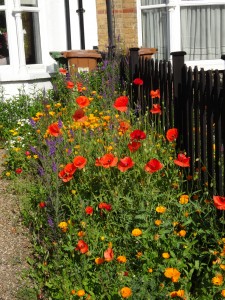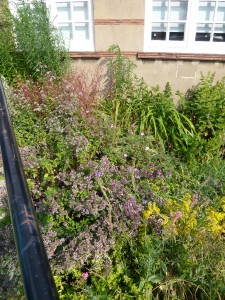Tips from the National Wildflower Centre for autumn activities for your wildflower garden.

Not all wildflowers, but an interesting mix in a neighbours front garden which is alive with insects in the summer. this shows how you don’t need a big area for an interesting display.
Collect Your Own Seed
Look for the seed in your wildflowers going brown and dry (dessicated). Simply collect this ripe seed and either drop it straight back down into an open space nearby, or put into containers.
On light soils rake off dead material under the plants, allow the seed to fall itself into the soil, and simply rake the area over.
Or keep some of your collected wildflower seed to sow next year. Dry out your seed on absorbent paper in a warm spot. Then store in a dry cool place over winter and sow again in spring.
Caring For Your Wildflower Patch in Autumn
First, see Collecting Your Own Seed above. Then, towards the end of August or in September, cut back hard. Take off the cuttings if they are thick and will block light, air and moisture reaching new seedlings. Sometimes in large areas, this is not possible or cost effective, so try to shred the cuttings as finely as you can – two passes of the mower or strimmer. If you do have a large area, don’t cut it all at once. Cut in sections at different times, to allow small mammals, insects, and other wildlife to move out and find another patch (Just like farmers should do when combining!)
Cut a few times again, if the autumn and winter are mild and grass and weeds keep growing. Put the mower away then, be ready to cut hard in late winter/early spring.
Looking for a selection of wildflower seeds to create the perfect wildflower habitat?
Did you know about our ranges of wild flower seeds found in the wild flower mixes section of the website? As well as single species wild flower seeds, we also offer a range of ready-made wild flower mixes. Alternatively you can also create your own wild flower meadow mixes. These packs offer great value for money and can create a colourful wildflower habitat in any garden or outdoor space.
We plan to change part of the small lawn at Bexley Community Library to a wildflower garden. We’ve left it to grow long grass the last two years in case there was anything very interesting in the sward. We got a few grasshoppers and bees and butterflies have liked our additional plantings, but now’s the time to get the boring grass out.
Here the Marjoram has been very popular with bees and butterflies.

